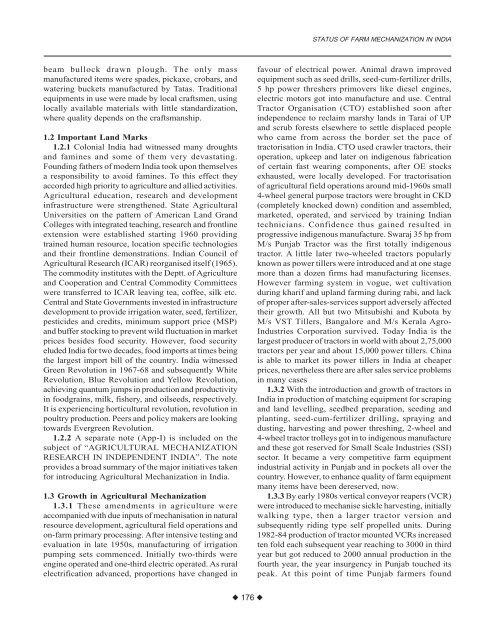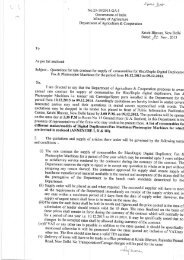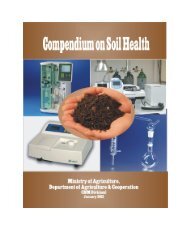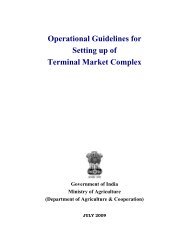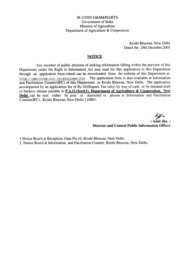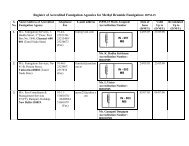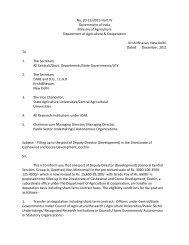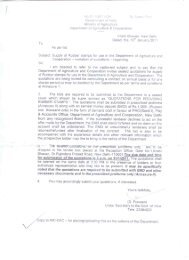Future Requirements of Agricultural Machines for Mechanizing ...
Future Requirements of Agricultural Machines for Mechanizing ...
Future Requirements of Agricultural Machines for Mechanizing ...
You also want an ePaper? Increase the reach of your titles
YUMPU automatically turns print PDFs into web optimized ePapers that Google loves.
eam bullock drawn plough. The only mass<br />
manufactured items were spades, pickaxe, crobars, and<br />
watering buckets manufactured by Tatas. Traditional<br />
equipments in use were made by local craftsmen, using<br />
locally available materials with little standardization,<br />
where quality depends on the craftsmanship.<br />
1.2 Important Land Marks<br />
1.2.1 Colonial India had witnessed many droughts<br />
and famines and some <strong>of</strong> them very devastating.<br />
Founding fathers <strong>of</strong> modern India took upon themselves<br />
a responsibility to avoid famines. To this effect they<br />
accorded high priority to agriculture and allied activities.<br />
<strong>Agricultural</strong> education, research and development<br />
infrastructure were strengthened. State <strong>Agricultural</strong><br />
Universities on the pattern <strong>of</strong> American Land Grand<br />
Colleges with integrated teaching, research and frontline<br />
extension were established starting 1960 providing<br />
trained human resource, location specific technologies<br />
and their frontline demonstrations. Indian Council <strong>of</strong><br />
<strong>Agricultural</strong> Research (ICAR) reorganised itself (1965).<br />
The commodity institutes with the Deptt. <strong>of</strong> Agriculture<br />
and Cooperation and Central Commodity Committees<br />
were transferred to ICAR leaving tea, c<strong>of</strong>fee, silk etc.<br />
Central and State Governments invested in infrastructure<br />
development to provide irrigation water, seed, fertilizer,<br />
pesticides and credits, minimum support price (MSP)<br />
and buffer stocking to prevent wild fluctuation in market<br />
prices besides food security. However, food security<br />
eluded India <strong>for</strong> two decades, food imports at times being<br />
the largest import bill <strong>of</strong> the country. India witnessed<br />
Green Revolution in 1967-68 and subsequently White<br />
Revolution, Blue Revolution and Yellow Revolution,<br />
achieving quantum jumps in production and productivity<br />
in foodgrains, milk, fishery, and oilseeds, respectively.<br />
It is experiencing horticultural revolution, revolution in<br />
poultry production. Peers and policy makers are looking<br />
towards Evergreen Revolution.<br />
1.2.2 A separate note (App-I) is included on the<br />
subject <strong>of</strong> “AGRICULTURAL MECHANIZATION<br />
RESEARCH IN INDEPENDENT INDIA”. The note<br />
provides a broad summary <strong>of</strong> the major initiatives taken<br />
<strong>for</strong> introducing <strong>Agricultural</strong> Mechanization in India.<br />
1.3 Growth in <strong>Agricultural</strong> Mechanization<br />
1.3.1 These amendments in agriculture were<br />
accompanied with due inputs <strong>of</strong> mechanisation in natural<br />
resource development, agricultural field operations and<br />
on-farm primary processing. After intensive testing and<br />
evaluation in late 1950s, manufacturing <strong>of</strong> irrigation<br />
pumping sets commenced. Initially two-thirds were<br />
engine operated and one-third electric operated. As rural<br />
electrification advanced, proportions have changed in<br />
◆ 176 ◆<br />
STATUS OF FARM MECHANIZATION IN INDIA<br />
favour <strong>of</strong> electrical power. Animal drawn improved<br />
equipment such as seed drills, seed-cum-fertilizer drills,<br />
5 hp power threshers primovers like diesel engines,<br />
electric motors got into manufacture and use. Central<br />
Tractor Organisation (CTO) established soon after<br />
independence to reclaim marshy lands in Tarai <strong>of</strong> UP<br />
and scrub <strong>for</strong>ests elsewhere to settle displaced people<br />
who came from across the border set the pace <strong>of</strong><br />
tractorisation in India. CTO used crawler tractors, their<br />
operation, upkeep and later on indigenous fabrication<br />
<strong>of</strong> certain fast wearing components, after OE stocks<br />
exhausted, were locally developed. For tractorisation<br />
<strong>of</strong> agricultural field operations around mid-1960s small<br />
4-wheel general purpose tractors were brought in CKD<br />
(completely knocked down) condition and assembled,<br />
marketed, operated, and serviced by training Indian<br />
technicians. Confidence thus gained resulted in<br />
progressive indigenous manufacture. Swaraj 35 hp from<br />
M/s Punjab Tractor was the first totally indigenous<br />
tractor. A little later two-wheeled tractors popularly<br />
known as power tillers were introduced and at one stage<br />
more than a dozen firms had manufacturing licenses.<br />
However farming system in vogue, wet cultivation<br />
during kharif and upland farming during rabi, and lack<br />
<strong>of</strong> proper after-sales-services support adversely affected<br />
their growth. All but two Mitsubishi and Kubota by<br />
M/s VST Tillers, Bangalore and M/s Kerala Agro-<br />
Industries Corporation survived. Today India is the<br />
largest producer <strong>of</strong> tractors in world with about 2,75,000<br />
tractors per year and about 15,000 power tillers. China<br />
is able to market its power tillers in India at cheaper<br />
prices, nevertheless there are after sales service problems<br />
in many cases<br />
1.3.2 With the introduction and growth <strong>of</strong> tractors in<br />
India in production <strong>of</strong> matching equipment <strong>for</strong> scraping<br />
and land levelling, seedbed preparation, seeding and<br />
planting, seed-cum-fertilizer drilling, spraying and<br />
dusting, harvesting and power threshing, 2-wheel and<br />
4-wheel tractor trolleys got in to indigenous manufacture<br />
and these got reserved <strong>for</strong> Small Scale Industries (SSI)<br />
sector. It became a very competitive farm equipment<br />
industrial activity in Punjab and in pockets all over the<br />
country. However, to enhance quality <strong>of</strong> farm equipment<br />
many items have been dereserved, now.<br />
1.3.3 By early 1980s vertical conveyor reapers (VCR)<br />
were introduced to mechanise sickle harvesting, initially<br />
walking type, then a larger tractor version and<br />
subsequently riding type self propelled units. During<br />
1982-84 production <strong>of</strong> tractor mounted VCRs increased<br />
ten fold each subsequent year reaching to 3000 in third<br />
year but got reduced to 2000 annual production in the<br />
fourth year, the year insurgency in Punjab touched its<br />
peak. At this point <strong>of</strong> time Punjab farmers found


